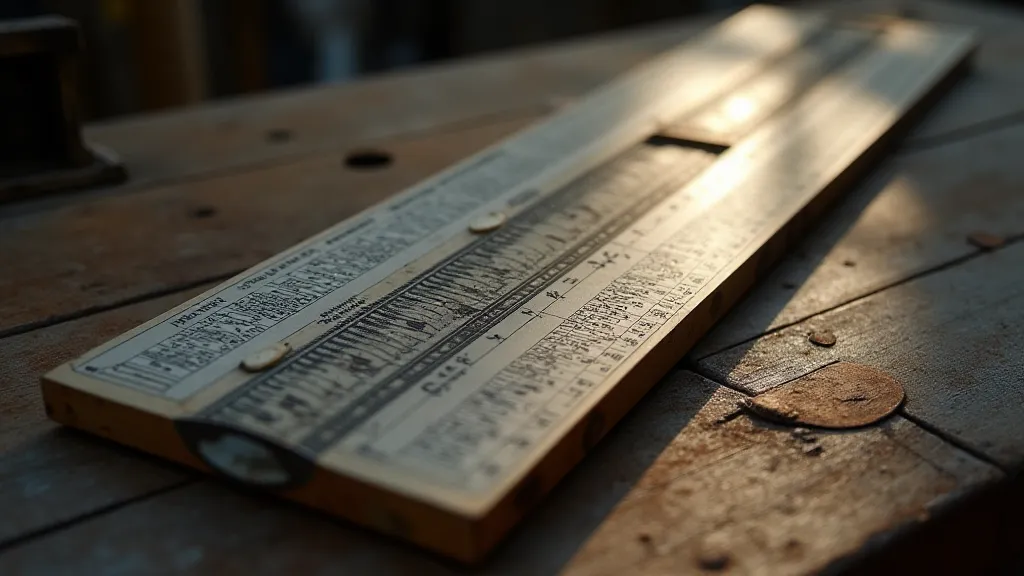Beyond the Decimal Point: Exploring the Role of Slide Rules in Scientific Discovery
There’s a peculiar beauty in the tangible. In a world increasingly dominated by ephemeral digital experiences, the feel of a well-worn object – a hammer crafted by a master, a hand-stitched quilt, or, yes, a slide rule – evokes a profound connection to the past. Holding a slide rule isn't just about grasping a tool; it’s about holding a piece of ingenuity, a testament to human problem-solving before the age of personal computers. It’s a link to a generation of engineers, scientists, and mathematicians who, without the benefit of instant calculation, achieved remarkable feats of discovery. My own fascination began with finding a battered Pickett Model N in my grandfather's workshop. Its faded markings and slightly chipped scales whispered tales of calculations performed, designs conceived, and challenges overcome. It wasn't just a tool; it was a legacy.

The Age of Mechanical Calculation
The slide rule’s story is inextricably linked to the rise of scientific inquiry and engineering innovation. Its roots lie in the work of William Oughtred in the 17th century, who combined the multiplication table and a proportional scale to create the first recognizable ancestor of the modern slide rule. However, it was the rapid advancements in engineering and science throughout the 19th and 20th centuries that truly propelled its popularity. Think of the burgeoning fields of railroad construction, electrical engineering, and aeronautics – all heavily reliant on accurate, albeit mechanical, calculations. Before the advent of electronic calculators, the slide rule wasn't just a convenience; it was an essential tool, often the *only* tool available.
The beauty of the slide rule isn't merely in its functionality, but in the ingenuity required to operate it. It doesn't *calculate* in the way a modern calculator does. Instead, it allows users to perform multiplication, division, exponents, roots, logarithms, and trigonometric functions by visually comparing scales. This process demands a deep understanding of mathematical relationships – a consequence that fostered a generation of mathematically literate engineers. There was a tangible reward for understanding the underlying principles.
Landmarks of Scientific Progress, Powered by Slide Rules
The impact of slide rules on scientific discovery is undeniable. While attributing specific discoveries solely to a tool can be problematic, the role of slide rules was often critical. Consider the early days of rocket science. Wernher von Braun, a pivotal figure in the development of rocketry, relied heavily on slide rules. The complex trajectory calculations needed to guide rockets – and, later, spacecraft – were routinely performed using these mechanical aids. The precision required to escape Earth's gravity and reach the Moon simply wouldn’s have been possible without the calculations readily available to those engineers. It’s humbling to realize the level of accuracy they achieved with such a comparatively simple instrument.
Similarly, the Manhattan Project, the top-secret research initiative during World War II that led to the development of the atomic bomb, depended significantly on slide rule calculations. Physicists and engineers faced immense mathematical challenges in designing and building the bomb, and slide rules were instrumental in tackling these complexities. While the ethical considerations of such projects remain a constant debate, it’s important to acknowledge the crucial role that this tool played.
Beyond these monumental undertakings, countless smaller, yet equally significant, advancements were facilitated by slide rule calculations. Civil engineers designing bridges, architects planning buildings, and surveyors mapping landscapes all leaned on the reliable assistance of this invaluable device.

The Craftsmanship and Design of a Timeless Tool
What made slide rules so endearing, beyond their practicality, was the inherent craftsmanship. The materials – often high-quality hardwoods like mahogany or walnut, and precisely engraved scales – reflected a commitment to durability and aesthetics. The quality of the engraving was, and remains, remarkable. Each marking, each number, was meticulously placed. The precision was paramount. Even a slight imperfection could render the slide rule inaccurate, and the tolerances were incredibly tight. The manufacturers—names like Pickett, Fuller, Mannheim, and Faber – established reputations for excellence, and their slide rules became prized possessions.
Consider the intricacies of a Pickett Model 1. The "Duplex" design, with its C and D scales for multiplication and division, was a revelation in its time. The curved scales, the split cursor, the quality of the engraving – every element was designed for efficiency and accuracy. These weren't mass-produced items churned out in a factory; they were crafted with care and a deep understanding of their purpose.
Collecting, Restoration, and Appreciation
Today, slide rules are primarily collector's items, treasured for their historical significance and aesthetic appeal. The collecting community is surprisingly vibrant, with enthusiasts eager to share their knowledge and passion. Identifying a slide rule – recognizing the manufacturer, model, and condition – is a skill in itself. Early models are particularly valuable, and those with original packaging or documentation are even more sought-after.
Restoration can be a delicate process. Cleaning a slide rule improperly can damage the scales or the wooden body. Repairing broken scales is incredibly difficult, and often best left to experienced restorers. Often, the best approach is to preserve the slide rule in its current condition, allowing its patina and wear to tell its story.

A Legacy of Ingenuity
The slide rule’s reign as the primary calculating tool may have ended with the advent of affordable electronic calculators, but its legacy endures. It represents a bygone era of ingenuity, a time when problem-solving demanded a deeper understanding of mathematical principles and a reliance on human intellect. More than just a tool, the slide rule embodies a spirit of innovation and a commitment to precision—a testament to the power of human endeavor and the enduring beauty of mechanical calculation. Holding one in your hand is more than just holding an antique; it’s holding a tangible connection to a generation of scientists, engineers, and dreamers who shaped the modern world, one slide rule calculation at a time.





